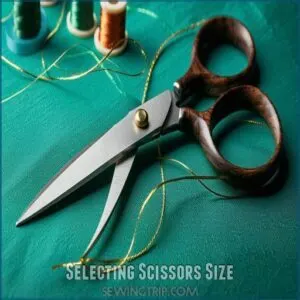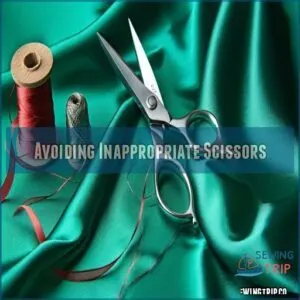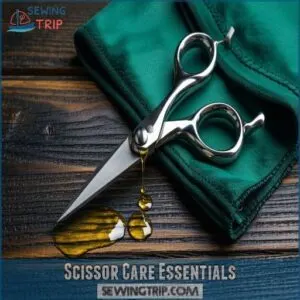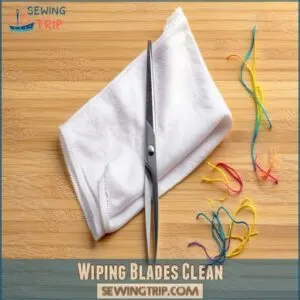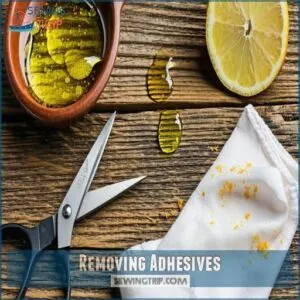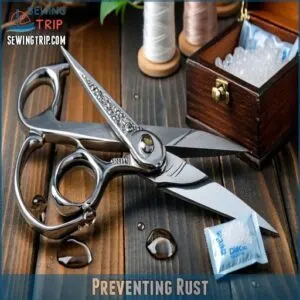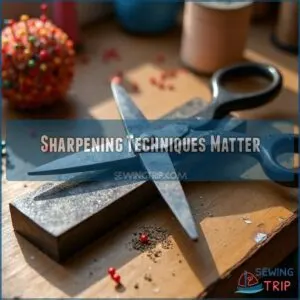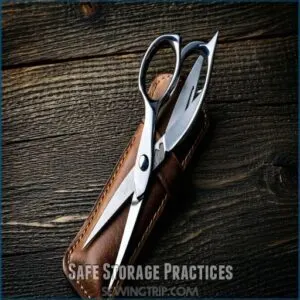This site is supported by our readers. We may earn a commission, at no cost to you, if you purchase through links.
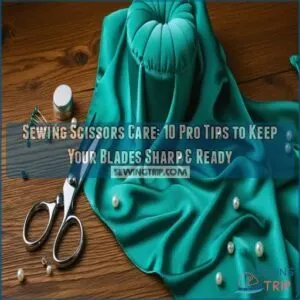 Your sewing scissors can slice like new for years with proper care. Keep them exclusively for fabric – using them on paper is like feeding a racehorse fast food!
Your sewing scissors can slice like new for years with proper care. Keep them exclusively for fabric – using them on paper is like feeding a racehorse fast food!
After each use, wipe the blades with a soft, lint-free cloth and store them in a protective case away from moisture. Oil the pivot points every few months to maintain smooth action.
For sticky residue, try natural solutions like coconut oil or white vinegar. Choose the right size and type for your projects – an 8-10 inch pair handles most tasks beautifully. With these basics mastered, you’ll discover even more ways to keep your trusted tools in top form.
Table Of Contents
Key Takeaways
- You’ll extend your scissors’ life by using them exclusively for fabric and storing them in a protective case away from moisture, preventing rust and maintaining sharpness.
- You’ll need different scissors for specific tasks – 8-10 inch fabric scissors for general cutting, pinking shears for preventing fraying, and embroidery scissors for detailed work.
- You’ll maintain sharp blades by wiping them clean after each use, removing adhesives with natural solutions like coconut oil or vinegar, and oiling the pivot points every few months.
- You’ll prevent damage by avoiding common mistakes like cutting over pins, using scissors on paper, or storing them in humid areas, keeping them in optimal cutting condition.
Scissor Selection Guide
You’ll save yourself a lot of headaches by choosing the right scissors for each sewing task, just like you wouldn’t use a butter knife to carve a turkey.
Whether you’re working with delicate silk or heavy upholstery, matching your scissors to your material makes all the difference in getting those clean, precise cuts you’re looking for.
Choosing Right Scissors Type
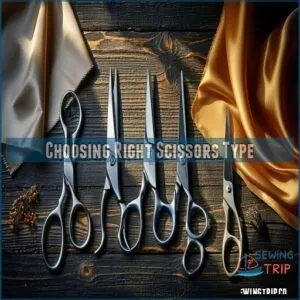
For sewing scissors, having the right blade types for each task makes all the difference. Here’s what you’ll need in your toolkit:
- Fabric scissors with micro-serrated edges for silk and delicates
- Heavy-duty shears with smooth blades for denim and upholstery
- Pinking shears for preventing fabric fraying
- Embroidery scissors for detailed threadwork
- All-purpose scissors with ergonomic handles for everyday cuts
To maintain your scissors and keep them in good condition, learning about scissors care is essential for any sewer. Your cutting action will be smoother and your edge durability longer when you match the right scissors to your material.
Selecting Scissors Size
Finding the perfect scissors size can make or break your sewing success.
The ideal Scissor Length for most projects is 8-10 inches, giving you excellent Cutting Capacity for various fabrics. Your Handle Size should match your hand’s dimensions for comfortable control, while Finger Space needs to feel just right.
To find the best sewing scissors, consider factors such as size, weight, and comfort. For detailed work, keep a pair of small sewing scissors handy.
Avoiding Inappropriate Scissors
Hey, you wouldn’t use a hammer to screw in a lightbulb, right? Same goes for your scissors – picking the wrong ones is a fast track to scissor abuse and dull blades.
Here’s how to avoid cutting errors and keep your sharp scissors care on point: Choosing the right scissors size is important for various sewing tasks.
- Skip using fabric scissors on paper – it’ll wreck your blades faster than you can say "oops"
- Never cut over pins or near adhesives
- Store them away from moisture to prevent scissors rust
Scissor Care Essentials
Now that you’ve picked your perfect pair, let’s talk about keeping them in top shape. Regular scissor maintenance isn’t just about blade protection – it’s your ticket to years of smooth cutting.
Give your scissors some TLC by oiling the pivot point every few months, and don’t forget the handle care. To prevent damage, follow these rust prevention methods.
You’ll know it’s time for attention when your cutting efficiency drops. Smart storage solutions make a difference too – keep your sewing scissors in a protective case away from moisture.
Think of scissors care tips as your insurance policy against dull, rusty blades.
Cleaning Scissors Properly
You’ll need more than just a quick wipe to keep your trusty sewing scissors in top shape, as tiny fabric fibers and sticky residues can build up faster than lint on a black sweater.
A proper cleaning routine will extend your scissors’ life and keep them cutting as smoothly as the day you bought them, saving you both time and money in the long run.
Wiping Blades Clean
Make blade sanitizing part of your regular scissors care routine. After each cutting session, grab a soft, lint-free cloth and give those blades a thorough dry wiping – it takes just seconds but makes a huge difference.
For fabric residue that’s built up during your projects, a gentle wipe with a clean microfiber cloth keeps your scissors slicing smoothly and prevents rust formation. This simple cleaning also helps remove built-up fabric residue.
Removing Adhesives
Sticky residue on your scissors can be a real headache, but these adhesive removal tips will get your blades clean in no time. For particularly stubborn messes, consider a specialized sticky scissors cleaner.
Here’s what works like magic:
- Mix equal parts baking soda and coconut oil with a few citrus oil drops
- Grab a citrus-based adhesive remover for tough spots
- Soak a cloth in undiluted white vinegar and wipe down
- Try acetone-based nail polish remover with a q-tip
- Let the cleaning solution sit for 10 minutes before wiping clean, using a cleaning solution that is effective.
Preventing Rust
Moisture is a scissor’s worst enemy, sneaking in when you least expect it.
To master corrosion control, wipe your blades thoroughly after each use and store them in a dry, well-ventilated spot.
For extra metal protection, try adding silica gel packets to your storage container.
Following rust prevention tips can also help extend the life of your scissors.
Keep your sewing assistant rust-free by avoiding bathroom storage and managing humidity levels with a dehumidifier in damp spaces.
Sharpening Techniques Matter
You’ll need more than just good cleaning habits to keep your sewing scissors in top shape – regular sharpening is the secret weapon that’ll transform your dull blades into cutting champions.
If you’ve ever struggled with ragged edges or fought to cut through fabric, you’ll love learning these pro sharpening techniques that’ll make your scissors glide through material like butter.
Regular Sharpening Importance
Your sewing scissors are like a trusted sidekick in your crafting journey – they’ve got to stay sharp to keep up with your creative flow. Regular sharpening isn’t just about maintenance; it’s about keeping your cutting game strong.
Here’s why sharpening matters:
- Sharp blades prevent fabric fraying and guarantee clean cuts
- Regular maintenance extends your scissors’ lifespan
- Well-maintained shears reduce hand fatigue
- Sharp blades help maintain fabric patterns’ accuracy
- Properly sharpened scissors glide through fabric effortlessly
Using Quality Sharpening Tools
For blade maintenance, quality sharpening tools are your best friends.
Use a whetstone with water or honing oil for pro-level edge refining, or try sandpaper with 180-220 grit for a quick fix.
For DIY scissors sharpening tips, aluminum foil and steel wool work wonders in a pinch.
Investing in a quality sharpening stone can also make a significant difference in maintaining sharp blades.
Even a knife sharpener can boost cutting efficiency with a simple dragging motion.
Maintaining Clean Cuts
Through proper cutting edge maintenance, you’ll keep those blades slicing fabric like butter. Start by cleaning your scissors after each use – a quick wipe prevents debris build-up that can dull the blade sharpness.
Don’t skip regular scissor lubrication; it’s key for precision cutting. To achieve best results, consider learning about scissor sharpening techniques.
Keep your fabric preparation area clean and pin-free to avoid nicks that can damage the blade’s edge.
Safe Storage Practices
You’ll want to give your trusty sewing scissors a proper home when they’re not busy snipping away at fabric.
A protective case or sheath isn’t just a cozy spot for your scissors – it’s your best defense against dulled blades, accidental drops, and those dreaded rust spots that can show up when you least expect them.
Storing Scissors Securely
Now that your scissors are sharp, let’s talk about keeping them safe.
A cool, dry place is your best bet for storing scissors securely. Think about hanging them on a magnetic strip or tucking them into a dedicated drawer organizer.
You’ll want to protect those blades from moisture and rust. A fabric case or sheath works wonders, keeping your investment safe while extending its lifespan.
Preventing Accidental Drops
Beyond secure storage, let’s tackle those heart-stopping moments when scissors slip from your hands.
Here are proven drop prevention tips that’ll save your blades from disaster:
- Add grip tape to handles for better control
- Keep a scissors holster attached to your work table
- Place a foam mat under your workspace to cushion any falls
- Use a wrist strap for extra fall protection during detailed work
These scissor safety habits prevent costly damage and keep your tools cutting perfectly.
Keeping Scissors Out Reach
Within your sewing room, creating a dedicated high-shelf space for your precious scissors isn’t just about Child Safety Tips—it’s smart Accident Prevention.
Install a magnetic strip above your workspace or use a lockable drawer for secure placement.
You’ll protect both your investment and curious hands, while keeping your scissors readily accessible for your next project, which is a result of a thoughtful scissors storage routine that makes everyone safer.
Frequently Asked Questions (FAQs)
Do you need scissors to cut fabric?
Yes, you’ll need scissors to cut fabric effectively and precisely.
While rotary cutters work for straight lines, scissors give you better control for curves, corners, and detailed cuts in your sewing projects.
How do you care for sewing scissors?
Keep your scissors sharp by wiping blades after use, oiling the pivot point monthly, and storing them in a dry case.
Don’t cut paper or let others borrow them – they’re your precious tools!
Do you need a pair of sewing scissors?
Investing in quality sewing scissors is essential for precise cuts on fabric projects.
They’ll save you time and frustration compared to regular scissors, which can damage delicate materials and make your work harder.
How to clean Japanese scissors?
You’ll need to clean your Japanese scissors gently with a soft cloth after each use.
For tougher residue, dab rubbing alcohol on the blades.
Wipe both sides thoroughly and oil the pivot point.
How do I keep my scissors ready to go?
Keep scissors sharp by wiping blades after each use, applying light oil to the pivot point monthly, and storing them in a protective case.
Regular professional sharpening guarantees clean cuts and extends their lifespan.
How do you clean a sewing machine scissors?
Like a spa day for your trusty tools, wipe down your scissors with a soft cloth and rubbing alcohol after each use.
Don’t let water near the blades, and oil the pivot point monthly.
How do you maintain sewing scissors?
Wipe your scissors with a soft cloth after each use, tighten pivot screws monthly, and apply a drop of light machine oil.
Don’t cut paper or non-fabric materials, and store them in a protective case.
What ruins fabric scissors?
Your favorite scissors won’t stay sharp if you cut paper, drop them, cut over pins, store them in damp places, or force thick materials.
Dishwashers and improper storage can also damage the blades.
Are you supposed to oil scissors?
Yes, you’ll need to oil scissors regularly.
Add a drop of light machine oil to the pivot screw and between blades every few months.
Wipe off any excess and test with fabric scraps.
What is the proper maintenance of scissors?
Did you know 78% of scissors lose sharpness within a year?
Maintain your scissors by tightening pivot screws, applying oil drops, wiping blades after use, scheduling professional sharpening, and storing them in protective cases.
Conclusion
There’s no cutting corners regarding sewing scissors care – it’s the thread that ties together all your crafting success.
You’ve now got the complete toolkit to keep your scissors in prime condition.
Remember, treating your scissors right means they’ll be ready whenever inspiration strikes.
With proper cleaning, storage, and maintenance, you’re set for years of precise cuts and beautiful projects. Trust these care tips, and your scissors will stay as sharp as the day you bought them.
- https://www.blog.wawak.com/post/how-to-care-for-your-sewing-scissors
- https://medium.com/two-little-kits/how-to-take-care-of-your-fabric-scissors-a4460b7c6b1c
- https://letslearntosew.com/how-to-care-for-sewing-scissors/
- https://www.sewingsupport.com/sewing-how-to/sewingsupport-articles/how-to-care-for-your-sewing-scissors.html
- https://themotherhuddle.com/how-to-care-for-your-sewing-scissors/

